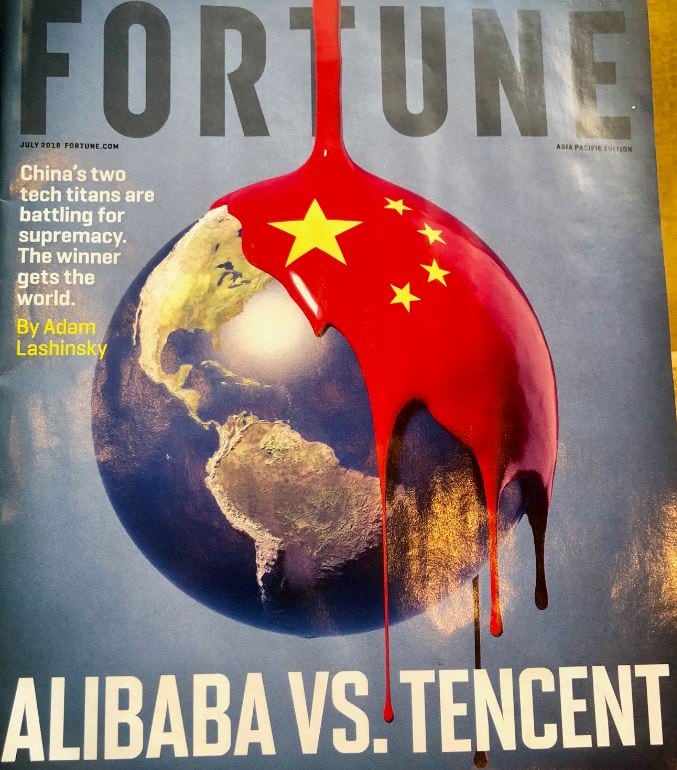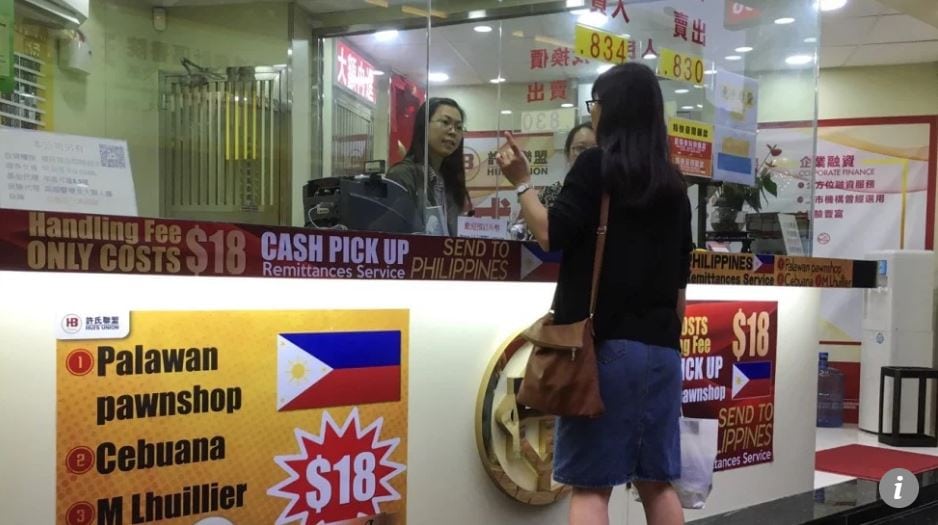
I bet you were wondering why I hadn’t written an Ant update recently. Well, I thought it was getting too much … but then I just arrived in Hong Kong and the hotel has kindly given me a copy of Fortune magazine with the headline cover page talking about the battle between Alibaba and Tencent.
It’s a fascinating read, with which I am very familiar, and analyses the cultural differences between the two companies. It misses some key areas, such as the global footprint of Ant Financial through partnership in every geography, and focuses more on the Chinese domestic play, but it’s definitely worth a read if you’re interested in what’s happening … and you should be, as the markets that will change tomorrow’s world are those with scale: USA, China, India, Indonesia and more. When you have over 200 million people living in a country, you can produce scaled products fast. In fact, it’s a key challenge for Europe, where the combined region has over 600 million people but the largest country has 80 million. Similarly with South-East Asia, where Singapore dominates but is a small population, and scale is hard when you cannot populate across borders.
This is why the China internet phenomena is so important and it’s very well illustrated by the Fortune write-up. Here are some key sections and walk-aways that I highlighted:
Alibaba and Tencent. Both have market capitalizations that hover around half a trillion U.S. dollars. Both command sectors of the rapidly growing Chinese digital landscape: Tencent owns the leading gaming and messaging platform, while Alibaba rules e-commerce. Both are aggressive investors inside and outside China. Each is the pride of their not-quite-first-tier hometowns: Alibaba of the ancient city of Hangzhou near Shanghai and Tencent of shiny-new Shenzhen across the border from Hong Kong. Finally, both touch an astounding percentage of the world’s most populous country: Alibaba’s various online marketplaces count 552 million active customers; Tencent’s WeChat messaging service recently surpassed 1 billion accounts …
Alibaba and Tencent attack the market differently, in ways that have often allowed them to grow without butting heads. Alibaba’s is largely a strategy of buying controlling stakes in businesses that are a fit with its commerce platform; Tencent takes hundreds of minority stakes in an array of businesses to win over partners and gain access to their technology. What’s more, the competition is hardly a zerosum game, thanks to the rapidly expanding Chinese middle class …
Commerce, in fact, is the glue that holds together Alibaba’s disparate parts. It began Alipay as a way to let merchants collect from shoppers on Taobao. Now Alipay is part of Ant Financial, which recently raised $14 billion, thought to be the largest venture capital investment ever. Alibaba co-opted “Singles Day,” an unofficial holiday that celebrated unmarried adults, creating what Americans would call a “Hallmark holiday” by turning it into a nationwide orgy of e-commerce. Singles Day in 2017 rang up total sales of $25.3 billion—that’s almost $6 billion more than Americans spent online over the entire five-day Thanksgiving weekend shopping period. Alibaba also stitched together an alliance of shipping companies to form a China-wide delivery giant called Cainiao, in which Alibaba has steadily increased its ownership stake. Its goal, as dictated by Jack Ma, is to be able to deliver merchandise anywhere in China within 24 hours, no small feat, and globally in 72 hours, also a stretch goal …
It is difficult for those outside China to appreciate the ubiquitous power of WeChat. Tencent ingeniously appropriated an older technology, the two-dimensional QR code, in empowering WeChat to utilize a smartphone’s camera to scan all manner of information. QR codes are how people in China exchange their contacts or download coupons. Once Tencent added WeChat Pay in 2013, the codes became a convenient way to exchange money too. Says Pony Ma: “We have transformed WeChat from people-to-people connections to people-to-service connections.”
Indeed, with WeChat recently having surpassed 1 billion accounts— some users have more than one—the service is becoming something akin to a digital operating system for the entire economy. This isn’t an accident. In 2014, WeChat offered a digital product called a “red envelope” that mimicked the centuries-old custom of giving gifts of money at the Chinese New Year. The feature went viral, and by the end of last year, 800 million users had linked WeChat to their bank accounts. “Now everywhere in China, in parking lots, farmers’ markets, even at temples, and beggars on the streets, they all accept WeChat Pay with a simple scan,” boasts Pony Ma.
The shrewd adoption of technology to cultural norms shows how both Tencent and Alibaba have moved well past copycat status. “Their success is due to their ability to be culturally innovative,” says Tricia Wang, a New York–based sociologist turned consultant who studies social digital behavior in China. “They got to where they are by hijacking the culture,” she says, citing Tencent’s red envelope success as well as Alibaba’s Singles Day stratagem. “They did a culture graft in the same way horticulturists perform grafts on plants.” This agility also has put the companies on a collision course. In 2014 Alipay powered 81% of online payments in China, per iResearch data. And while the mobile-pay market has grown some 16-fold since then, Alipay’s share has shrunk to 54%, while WeChat Pay now commands 38% …
[mini-apps are] a lightweight application inside WeChat that requires less development effort than a built-from-scratch app and doesn’t require consumers to download anything. Introduced only last year, mini-apps have taken Chinese e-commerce by storm. “Because of mini-apps, WeChat is starting to see this explosion of social commerce that is changing the face of China,” says Weinswig, the retail analyst. (This is an area America’s social media giants have attempted to exploit, with little success.) Weinswig says total 2017 retail sales were up 10.2% in China, compared with 4.2% in the U.S., and that WeChat added about as many mini-apps in a year as Apple’s online store added apps in its first four years.
I would suggest you read the whole article, if you want the real inside track.
This landed on my desk at the same time as another headline about Alipay. This one announced that they are launching a blockchain remittance system for, initially, Filipino workers to send money home from Hong Kong for almost free.
The blockchain-based service is being launched with GCash, Ant’s partnership with Philippines’ Global Telecom, for transfers between Hong Kong and the Philippines. This is the world’s third-largest remittance market with inflows of US$33 billion in 2017 according to Standard Chartered, which will act as the settlement bank for both AlipayHK and GCash for the blockchain transactions.
During the unveiling of the feature, provided on mobile apps GCash and Ant Financial’s Alipay, a Filipino worker in Hong Kong demonstrated her ability to transfer funds in three seconds. Jack Ma, speaking at the launch event, said he wants to make it possible for people to remit even 1 cent at almost no cost, compared with the higher fees charged by traditional remittance services like MoneyGram, which Ant tried to buy last year. Hong Kong’s banks and remittance outlets charge about HKD$18, and may impose other costs such as commissions or currency conversion fees on every transfer.
There are over 180,000 Filipinos in Hong Kong, making it the largest foreign community in the city according to Hong Kong’s Census and Statistics department, and they are sending around US$560 million a year home each year, so this is a big market to tap into. This is particularly true as remittances are a significant portion of income for Filipino workers—representing about 10.2% of the Philippines’ GDP in 2016, according to data from the World Bank. More importantly, after US authorities blocked the strategic acquisition of MoneyGram by Ant Financial last year, this is an important step in disrupting the whole remittance market model. After all, if you send home one cent for free in three seconds, who would pay $18 to send home a minimum $100 in days?
It's also worth noting that Ant Financial claim to be a "technology company" first and foremost, rather than a "financial firm". As the 10th largest financial institution in the world by valuation ($150 billion), that may come as a surprise but, in another recent announcement, they say that:
In five years, technology services will make up 65 percent of Ant Financial’s revenue, compared with an estimated 34 percent in 2017, according to confidential company projections viewed by Reuters. That would involve helping banks and other institutions with services like online risk management and fraud prevention. Meanwhile, revenue from financial services is projected to shrink to 6 percent from an estimated 11 percent, and the contribution from payments will be reduced to 28 percent from an estimated 54 percent in 2017, the figures show.Overall revenue is projected to grow at 40 percent annually from 2017 to 2021, the figures show.
An interesting change of positioning.
Finally, a friend sent me another link to this video of Dr Yuan (Alan) Qi, VP & Chief Data Scientist for Ant Financial Services, giving a presentation on Ant's AI enablement that brings efficiency, effectiveness and experiential improvements across the whole range of their services.
Ah well, I may have been quiet on the Alipay front for a while, but the Ant Financial train is still steaming out of the station. Are you keeping up?
Chris M Skinner
Chris Skinner is best known as an independent commentator on the financial markets through his blog, TheFinanser.com, as author of the bestselling book Digital Bank, and Chair of the European networking forum the Financial Services Club. He has been voted one of the most influential people in banking by The Financial Brand (as well as one of the best blogs), a FinTech Titan (Next Bank), one of the Fintech Leaders you need to follow (City AM, Deluxe and Jax Finance), as well as one of the Top 40 most influential people in financial technology by the Wall Street Journal's Financial News. To learn more click here...



